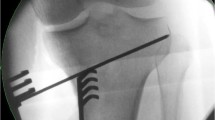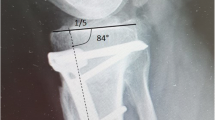Abstract
Purpose
Limited literature reports on internal and external rotation of the distal fragment in the context of valgus open wedge (OW) high tibial osteotomy (HTO). In the authors clinical observation, the distal fragment was always rotated internally in relation to the proximal fragment by the end of the surgical procedure. The purpose was to evaluate the influence of valgus OW-HTO on post-operative tibial torsion.
Study design
Prospective case series.
Methods
Fifty patients (10 female, 40 male; mean age 42.1 ± 9.4 years) underwent valgus OW- HTO. The osteotomy was spread and fixed with a locking plate at the posteromedial aspect of the proximal tibia. The osteotomy of the tibial tuberosity was performed either proximally or distally dependent on the patello-femoral findings. Two independent observers measured axial tibial rotation using K-wires placed into the anterior margin of the tibia proximal and distal to the osteotomy.
Results
An overall mean of 4.4 ± 2.8° internal rotation of the distal tibia has been shown. In four patients with additional single step double bundle ACL-replacement after harvesting ipsilateral autologous hamstring grafts, the distal tibia rotated internally by 0.1 ± 0.3°, accordingly in the other 46 patients by 4.8 ± 2.6°.
Conclusions
Valgus OW-HTO produces significant internal axial rotation of the distal tibia. This might be caused by soft tissue tension of the medial hamstrings/soft tissue structures and the location of the lateral tibial hinge.
Clinical relevance
Surgeons have to take into consideration that valgus OW HTO might result in significant 3D changes of the tibia. Higher degrees of internal torsion of the tibia might influence overall gait mechanics and specifically alternate patellofemoral kinematics.



Similar content being viewed by others
References
W-Dahl A, Lidgren L, Sundberg M et al (2015) Introducing prospective national registration of knee osteotomies. A report from the first year in Sweden. Int Orthop 39:1283–1288
Akizuki S, Shibakawa A, Takizawa T et al (2008) The long-term outcome of high tibial osteotomy: a ten- to 20-year follow-up. J Bone Joint Surg (Br) 90:592–596
Altay MA, Erturk C, Altay N et al (2015) Clinical and radiographic outcomes of medial open-wedge high tibial osteotomy with Anthony-K plate: prospective minimum five year follow-up data. Int Orthop. doi:10.1007/s00264-015-2919-z
Amendola A, Panarella L (2005) High tibial osteotomy for the treatment of unicompartmental arthritis of the knee. Orthop Clin N Am 36:497–504
Baumgarten KM, Meyers KN, Fealy S et al (2007) The coronal plane high tibial osteotomy. Part II: a comparison of axial rotation with the opening wedge high tibial osteotomy. HSS J 3:155–158
Coventry MB, Ilstrup DM, Wallrichs SL (1993) Proximal tibial osteotomy. A critical long-term study of eighty-seven cases. J Bone Joint Surg Am 75:196–201
Faschingbauer M, Nelitz M, Urlaub S et al (2015) Return to work and sporting activities after high tibial osteotomy. Int Orthop 39:1527–1534
Fouilleron N, Marchetti E, Autissier G et al (2010) Proximal tibial derotation osteotomy for torsional tibial deformities generating patello-femoral disorders. Orthop Traumatol Surg Res 96:785–792
Gaasbeek R, Welsing R, Barink M et al (2007) The influence of open and closed high tibial osteotomy on dynamic patellar tracking: a biomechanical study. Knee Surg Sports Traumatol Arthrosc 15:978–984
Hefzy MS, Jackson WT, Saddemi SR et al (1992) Effects of tibial rotations on patellar tracking and patello-femoral contact areas. J Biomed Eng 14:329–343
Hinterwimmer S, Beitzel K, Paul J et al (2011) Control of posterior tibial slope and patellar height in open-wedge valgus high tibial osteotomy. Am J Sports Med 39:851–856
Hsu RW, Himeno S, Coventry MB et al (1990) Normal axial alignment of the lower extremity and load-bearing distribution at the knee. Clin Orthop Relat Res 255:215–227
Jang KM, Lee JH, Park HJ et al (2015) Unintended rotational changes of the distal tibia after biplane medial open-wedge high tibial osteotomy. J Arthroplasty 31(1):59–63
Kenawey M, Liodakis E, Krettek C et al (2011) Effect of the lower limb rotational alignment on tibiofemoral contact pressure. Knee Surg Sports Traumatol Arthrosc 19:1851–1859
Kendoff D, Lo D, Goleski P et al (2008) Open wedge tibial osteotomies influence on axial rotation and tibial slope. Knee Surg Sports Traumatol Arthrosc 16:904–910
Lee TQ, Morris G, Csintalan RP (2003) The influence of tibial and femoral rotation on patellofemoral contact area and pressure. J Orthop Sports Phys Ther 33:686–693
Macwilliams BA, Mcmulkin ML, Baird GO et al (2010) Distal tibial rotation osteotomies normalize frontal plane knee moments. J Bone Joint Surg Am 92:2835–2842
Magyar G, Toksvig-Larsen S, Lindstrand A (1999) Changes in osseous correction after proximal tibial osteotomy: radiostereometry of closed- and open-wedge osteotomy in 33 patients. Acta Orthop Scand 70:473–477
Mani S, Kirkpatrick MS, Saranathan A et al (2011) Tibial tuberosity osteotomy for patellofemoral realignment alters tibiofemoral kinematics. Am J Sports Med 39:1024–1031
Marti CB, Gautier E, Wachtl SW et al (2004) Accuracy of frontal and sagittal plane correction in open-wedge high tibial osteotomy. Arthroscopy 20:366–372
Server F, Miralles RC, Garcia E et al (1996) Medial rotational tibial osteotomy for patellar instability secondary to lateral tibial torsion. Int Orthop 20:153–158
Takai S, Sakakida K, Yamashita F et al (1985) Rotational alignment of the lower limb in osteoarthritis of the knee. Int Orthop 9:209–215
Wang JH, Bae JH, Lim HC et al (2009) Medial open wedge high tibial osteotomy: the effect of the cortical hinge on posterior tibial slope. Am J Sports Med 37:2411–2418
Author information
Authors and Affiliations
Corresponding author
Rights and permissions
About this article
Cite this article
Hinterwimmer, S., Feucht, M.J., Paul, J. et al. Analysis of the effects of high tibial osteotomy on tibial rotation. International Orthopaedics (SICOT) 40, 1849–1854 (2016). https://doi.org/10.1007/s00264-015-3100-4
Received:
Accepted:
Published:
Issue Date:
DOI: https://doi.org/10.1007/s00264-015-3100-4




